| کد مقاله | کد نشریه | سال انتشار | مقاله انگلیسی | نسخه تمام متن |
|---|---|---|---|---|
| 1282696 | 1497593 | 2010 | 16 صفحه PDF | دانلود رایگان |

Dual-fuel compression ignition (CI) engine operation with hydrogen is a promising method of using hydrogen gas in CI engines via high-cetane pilot fuel ignition. However, hydrogen dual-fuel operation with neat pilot fuels typically produce: high NOx emissions; and high combustion chamber pressure rise rates (leading to increased “Diesel knock” tendencies). While water-in-fuel emulsions have been used during normal CI engine operation to cool the charge and slow combustion rates in an effort to reduce NOx emissions, these water-in-fuel emulsions have not been tested as pilot fuels during hydrogen dual-fuel combustion. In this work two water-in-biodiesel emulsions are tested as pilot fuels during hydrogen dual-fuel operation. Hydrogen dual-fuel operation generally produces at best comparable thermal efficiencies compared with normal CI engine operation, while the emulsified biodiesel pilot fuels generally increase thermal efficiencies when compared with the neat biodiesel pilot fuel during dual-fuel operation. There is also a clear reduction in NOx emissions with emulsified pilot fuel use compared with the neat pilot fuel. The thermal efficiency increase is more apparent at higher engine speeds, while the NOx reduction is more apparent at lower speeds. This is due to two conflicting effects (exclusive to emulsified pilot fuel) that occur in tandem. The first is the cooling effect of water vapourisation on the charge, while the second is the microexplosion phenomenon which enhances fuel-air mixing. The NOx emission reduction is due to the emulsified pilot fuel lowering pressure rise rates compared with the neat pilot fuel, while the efficiency increase is due to a more homogeneous charge resulting from the violent microexplosion of the emulsified pilot fuel. Smoke, CO, HC and CO2 emissions remain comparable to neat pilot fuel tests. Overall, emulsified pilot fuels can reduce NOx emissions and increase thermal efficiencies, however not at the same instance and under different operating conditions. The general trends of reduced power output, reduced CO2 and increased water vapour emission during hydrogen dual-fuel operation (with neat pilot fuels) are also maintained.
Journal: International Journal of Hydrogen Energy - Volume 35, Issue 24, December 2010, Pages 13329–13344